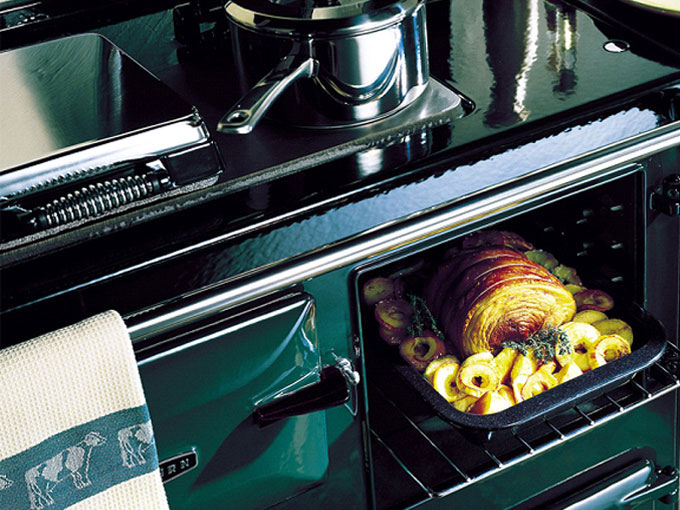Buying a Rayburn
While everyone knows that Rayburn cookers are great at cooking delicious and succulent food, are you aware of what else they are useful for? Don't worry if you're not as our infographic below is going to tell you all of the fun facts that you need to know about your Rayburn cooker.
For example, did you know that you could dry awkward metal items on your Rayburn to prevent them from rusting or that you could incubate farm animals in your Rayburn cooker? You'll also find out that a large proportion of Rayburn cookers are made from recycled materials such as lamp posts and old cast iron cookers.
Take a look below to find out 20 interesting and unusual facts about the Rayburn cooker - you'll be surprised at what these clever cookers can do.
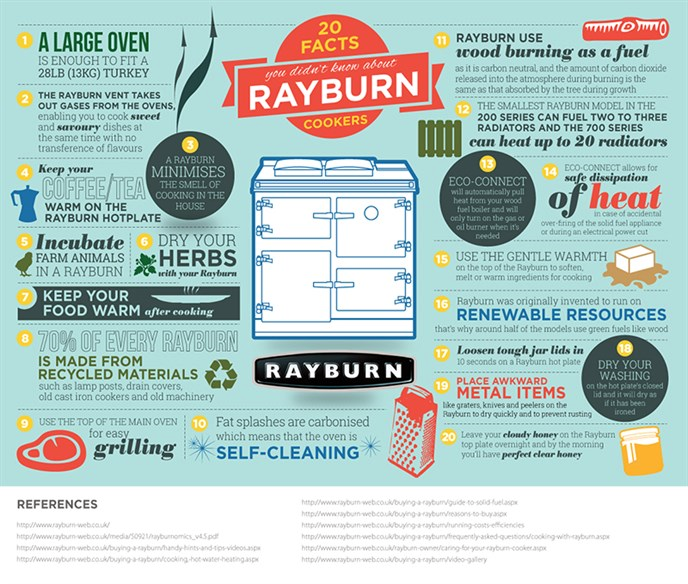
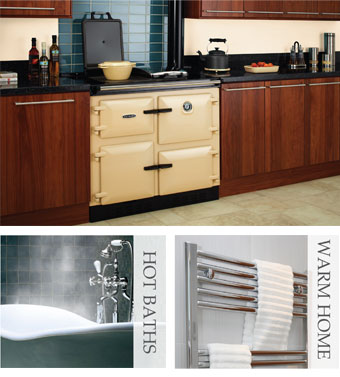 With its beautifully enamelled exterior and classic styling a Rayburn cooker will transform your kitchen into a warm and welcoming space.
With its beautifully enamelled exterior and classic styling a Rayburn cooker will transform your kitchen into a warm and welcoming space.
From high heat cooking which quickly brings out the best in vegetables, to gentle roasting and brilliant baking, Rayburn Cookers truly are masters of all culinary styles.
Manufactured from cast iron, Rayburn uses indirect heat technology to cook food.
We call this 'kind-to-food' heat because it seals in the flavours and natural juices, creating healthier, more delicious dishes.
For more than seventy years, Rayburn has been the warm heart of many British homes, leading the field in central heating range cookers.
Below are just a few reasons why hundreds of thousands of happy Rayburn owners love our range of products. To experience why the Rayburn has such long standing popularity, why not visit one of our Rayburn Stockists, request a brochure or visit one of our Rayburn demonstrations to see our products first hand and experience the difference they could make to your home.
 1. A central heating system and cooker in one neat package
1. A central heating system and cooker in one neat package
Beneath the classically beautiful exterior of a Rayburn lies a highly efficient combined heating and cooking system that creates mouth-watering dishes, a wonderfully warm home and piping hot water, just when you need it. What's more, with the added convenience of having all your heating, hot water and cooking in one, you can use valuable additional space for other appliances - or creative space!
 2. Workhorse in the home
2. Workhorse in the home
Nothing's more honest than a Rayburn. Throughout history Rayburn has been inseparable from life in the country. When Shire horses ploughed the fields and generations of families worked the land, a Rayburn range was always at the centre of family life providing heating, hot water and cooking for all.
 3. Better Food
3. Better Food
The Rayburn is a brilliant cooker that produces amazing succulent food from cast iron ovens. Using the principle of indirect heat, the ovens gently cook food and lock in flavour, moisture and goodness.
 4. The Green Choice
4. The Green Choice
With solid fuel and 'A' efficiency rated gas and oil options, the Rayburn is the ideal choice for those who care for the environment as much as they care about good food and a warm home.
 5. Design classic
5. Design classic
The iconic smooth lines, attractive colours and solid reliability of a Rayburn have created a design classic that blends in perfectly with any home. The compact dimensions of the 200 Series perfectly suit smaller kitchens, whilst the 600 has the largest hotplate on the market and a main oven that's a full 16% bigger than other smaller Rayburn models.
 6. Proud heritage
6. Proud heritage
For 65 years, the Rayburn has been made by skilled craftsmen at the company's historic foundry in Coalbrookdale, Shropshire - the birthplace of the Industrial Revolution. We are hugely proud that time honoured traditions of skilled craftsmen have been passed down from one generation to the next and that each and every model is made here in the UK.
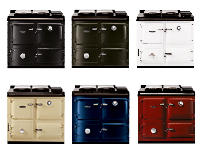 7. Options and colours to suit every home
7. Options and colours to suit every home
Choice of fuel is becoming increasingly important so we have a range of fuel options to choose from. These include wood and solid fuel such as manufactured smokeless fuel (MSF) or peat briquettes, propane gas, natural gas and kerosene oil. Plus with seven colour options to choose from, you're sure to find one that's perfect for your kitchen.
 8. Controllable, flexible and programmable
8. Controllable, flexible and programmable
In keeping with the latest home heating and hot water systems, all modern Rayburn cookers are fully programmable, fitted with thermostats. Some even benefit from digital controls. Sophisticated digital sensors monitor both the oven and boiler to ensure constant temperatures and an advanced control unit will alert you of any issues. The flexibility to decide when you need your Rayburn on or off, in turn means lower fuel bills.
 9. A Large Proportion of every Rayburn is made from recycled materials
9. A Large Proportion of every Rayburn is made from recycled materials
Unlike other types of cooker, every Rayburn is almost completely recyclable, with a large proportion of each Rayburn made from used materials such as lamp posts, drain covers, old cast iron cookers, old machinery and much more.
 10. A wide range of boilers to power any size of home
10. A wide range of boilers to power any size of home
From the smallest model in our 200 Series that can fuel two or three radiators, to the largest of the 600 Series that can heat up to 20 radiators, there's a boiler to suit any size of home. What's more, the use of the very latest boiler design and burner technologies deliver the high levels of efficiency you would expect from modern heating systems.
Not only do Rayburn cookers make delicious food but some models also have the ability to provide you with central heating. There is a boiler to suit every home - the smallest Rayburn model is able to heat two to three radiators and the largest model is able to heat up to 20 radiators. With a model that provides heating and cooking, you can still cook without having to use the central heating, as the twin burner models have separate burners for each of the tasks. Certain models also have a programmer that allows you to set the heating and cooker to come on separately.
To help you choose the right Rayburn cooker for you, you should have a site survey carried out as it will ensure that you are able to find a cooker that meets your needs and requirements. It should be carried out by a qualified installer, such as a Rayburn Heat Centre Engineer.

GAS
Natural gas is said to be one of the cleanest burning energy sources for the home, it produces less sulphur dioxide, less particulate matter and less nitrogen - which means that it has a lower risk of smog and health and visibility affects. Natural gas is also very efficient.
LPG or Liquid Petroleum Gas is propane gas that is bottled in cylinders, it's normally used when houses do not have gas mains nearby for a natural gas supply. However, LPG is the cleanest burning rural fossil fuel available and emits less carbon than other fuels.
OIL
Rayburn cookers were traditionally run on oil and are still a popular choice for many homes, with over 1.5 million in the UK using it. Oil is an economical and efficient tool that can supply you with reliable central heating, hot water and cooking. It's worth noting that it is cheaper to buy a big tank of oil when you get your cooker rather than to fill up smaller tanks throughout the year. The oil tank also needs to be adjacent to the home to fuel it efficiently.
SOLID FUELS
Every Rayburn that is able to run on solid fuel can be fuelled with natural, carbon neutral wood or manufactured smokeless fuel - they are also available in wood only, if that's what you would prefer.
If you are choosing to burn wood then it's important to ensure that it is completely dry - if the wood is high in moisture or damp and wet it can cause tar and smoke. This tar and smoke has the potential to harm your flue.
A solid fuel Rayburn has low running costs and is an environmentally friendly way of heating your home. Burning wood releases the same amount of carbon dioxide to the atmosphere as it would if it was left to decompose on the floor, the trees then absorb that carbon dioxide and the cycle is repeated.
One of the advantages of solid fuel is that it if there is a power cut or a supply failure you will not be affected because you are not reliant on the energy suppliers. However, you do need to ensure that you are always stocked up.
BOILERS
Rayburn boilers are regular boilers and heat your central heating system directly, in addition to producing hot water for your cylinder - a cylinder is required for the hot water and most are suitable for a Rayburn.
From low output options (1.9kW/6,000Btu) to provide domestic hot water to high output boilers (29.3kW/100,000Btu) capable of heating 20 radiators there is a Rayburn boiler to suit just about any requirement. The Rayburn range offers high efficiency 'A' rated condensing models which are up to 92.2% efficient.
APPLICATION OF ALTERNATIVE AND GREEN TECHNOLOGIES

There are plenty of options and system combinations - for both new build houses and existing systems. With a number of other sources of energy that can be incorporated to work in conjunction with your Rayburn, including ground source (geo thermal) heat pumps, solar thermal, biomass, wood logs and pellet - the choice is yours.
Rayburn cookers are also compatible with under floor heating and zoning. The efficiency of a heating system is greatly increased by dividing the home into distinct heating zones covering different heating needs. In most cases there is no need to heat bedrooms during the day, when they are not in use, or to run the whole system at the same temperature.
EFFICIENCY AND RUNNING COSTS
When it comes to efficiency, Rayburn models are among some of the best. They do as much as they can for as little as possible and some models also offer complete control over the central heating, cooking and hot water so that you can amend it to suit your own lifestyle.
Rayburn boilers are highly rated for both energy efficiency and fuel use. However, you will need to contact a qualified heating engineer to calculate how much your central heating will cost to run from your Rayburn - costs will vary as they will depend on the size and type of your house.
Rayburn cookers may even be able to reduce some costs within the home by completing tasks that would otherwise cost money and energy, such as: drying the dishes or washing and keeping drinks and food warm. Because of its ability to produce heat slowly and efficiently in to the room, you may not even need a radiator in the kitchen, which could save you energy and money.
The Rayburn itself is also efficient as it is made from seventy per cent of recycled materials.
INSTALLATION
Installing a cooker with central heating needs to be done correctly to ensure that it is safe and connected properly. Before you install your appliance you should get advice from your Rayburn retailer or a Rayburn Guild member as they can advise you on any issues that you may have and what you need for a successful installation. Each fuel needs to be installed by a qualified professional.
Gas ~ Gas fuelled Rayburns need to be installed by a registered Gas Safe engineer.
Oil Fired ~ This type of fuelled Rayburn needs to be installed by an OFTEC (Oil Firing Technical Association) registered engineer as they will need to complete a completion certificate to certify that the cooker is safe to use and has been installed accordingly.
Solid Fuel ~ Solid fuel Rayburns must be installed by a HETAS (Heating Equipment Testing and Approval Scheme) engineer.
SERVICING
Your Rayburn should be serviced once or twice a year and the service should always be carried out by a fully trained engineer. There are a number of Rayburn Heat Centre Engineers across the UK that are happy to service your Rayburn. As well as ensuring that a fully trained engineer services your appliance, you should also ensure that they are only using genuine Rayburn parts.
If you have a solid fuel or wood burning cooker then you will need to sweep the chimney and clean out the flues regularly - you can do this yourself if you have instructions from your manufacturer.
Self sufficient home cooking and heating
The Rayburn solid fuel and multi fuel series can be fuelled with natural, carbon neutral wood or solid fuels like heat logs, peat briquettes or manufactured Smokeless fuel.

WOOD FUEL
Probably the most important thing to ensure when you're burning wood is that it is really dry, so you should always try and use either kiln dried or seasoned wood logs. You can get good seasoned wood by buying it dry, or you can buy green logs and dry them yourself. You can tell if wood is well seasoned by bark that comes off easily and cracks appearing from the centre of the log. You should always avoid burning logs that aren't dry. Freshly harvested wood contains naturally high amounts of water, between 65 - 90% depending on the species. Burning damp logs or fresh logs with a high moisture content can create tars and smoke which can be corrosive, potentially damaging the lining of your flue and increasing the danger of a chimney fire. After seasoning, store your logs undercover to keep them dry and ready for use.
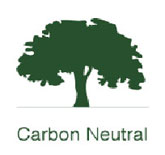 The Environment
The Environment
Burning wood is carbon neutral, because it only releases the same amount of carbon dioxide to the atmosphere as it would if were left to decompose on the forest floor. So when you're burning firewood you can be assured that you are not harming the environment. Trees reabsorb Carbon Dioxide from the atmosphere whilst they are growing, thus completing the cycle.
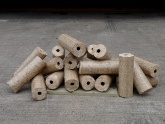 Solid Fuel
Solid Fuel
Solid fuel represents an efficient and economical method of fuelling your home. There is a wide range of manufactured smokeless fuels and heat logs to choose from. As you always hold stock, solid fuel gives you independence from reliance on large energy suppliers, ensuring that you don't need to worry about supply failures or power cuts. If you don't live in a Smoke Control Area you can also burn house coal. Contact your local Environmental Health Department for more information about Smoke Control Areas.
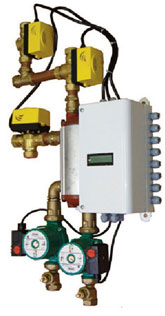 Linked Systems
Linked Systems
You don't have to be 100% reliant on your solid fuel boiler. We've developed a clever bit of kit called Eco-Connect, that actually allows you to link your solid fuel or wood burning central heating system with a gas or oil fired boiler, which means you can leave the solid fuel part off and fall back on the gas or oil heating when ever required. Eco-Connect will also automatically pull heat from your wood fuel boiler and only turn on the gas or oil boiler when it's needed. It therefore gives priority to the renewable energy source and features a display screen to tell you which fuel source it's pulling the heat from. The Eco-Connect will also mix the heat input from the two heat sources if the solid fuel boiler isn't quite generating enough hot water. Eco-Connect allows for safe dissipation of heat in the case of possible accidental over-firing of the solid fuel appliance or during an electrical power cut and has been third party tested and accredited and recently won OFTEC's award for Innovative product of the year.
 Flues
Flues
What is a flue and what does it do?
When we burn a fuel to release heat, gases such as Carbon Dioxide and water vapour together with some solid particles are produced, depending on the fuel being used. These need to be safely discharged into the outside atmosphere, where they quickly and harmlessly disperse. Solid fuel and wood-burning appliances need the flue to create a movement of air and thus oxygen across the firebed to make them burn. At some point of time in the burning cycle smoke may be produced or other particles which must also be taken away from the living areas.
The 'flue' is the means used to convey these 'products of combustion' from the cooker to outside.
Today's range cookers are highly efficient, incorporating state of the art burners and technology, thereby minimising emissions. Good news for our planet.
A flue can be part of a chimney, but there are various types and options, including models that can be flued directly through an outside wall.
The flue from a range cooker has one other important function to perform. During oven cooking operations, moisture is naturally driven off from the food. Our ovens are directly connected to the outside atmosphere, usually through the flue system, avoiding condensation and steam in the kitchen. So there's no need to deliberately open windows as you might need to with a conventional oven.
The cast-iron ovens have high surface temperatures ensuring that any fat splashes carbonise to powder; in effect, self cleaning. Any objectionable smells created are therefore also carried away by the flue.
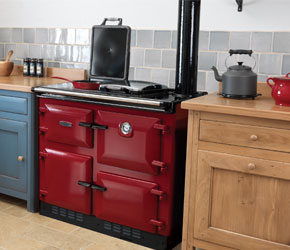 Conventional Flue
Conventional Flue
A conventional flue (sometimes called an openflue appliance) uses a flue continuously rising from the top of the cooker and terminating above the highest part of the roof.
Older properties may have a convenient chimney built of stone or brick which can be used for this purpose, providing that the inside is lined with an acid resistant material, again commonly referred to as the 'flue'.
Sometimes, when there is no masonry chimney, the flue-pipe from the cooker can be taken all the way up using special prefabricated flue systems consisting of twin-wall pipe and usually manufactured from stainless steel.
The type of material used depends on the fuel type and cooker model, as does the size of flue (diameter) This can range from 125mm (5") for some gas-fired models to 200mm (8") for a multifuel or woodburning cooker. Generally, models providing central heating as well as cooking require larger flues.
A single wall pipe connects between the cooker and the main chimney, preferably made of cast iron, as this matches the appearance of the cooker and helps to reduce noise levels. The flueway inside the main chimney should normally be one size larger in diameter than the connecting pipe.
Usually the flue must rise continually with no horizonal stretches and clear rules on the angle of any pipe that isn't truly vertical. Some solid fuel cookers (not oil or gas) can connect into a masonry chimney from the rear, with a maximum 150mm horizontal pipe.
Appliances must not share a flue, although there can of course be several separate flues travelling together inside a traditional chimney.
Conventional flued cookers can be sited on internal or external walls within the property as convenient.
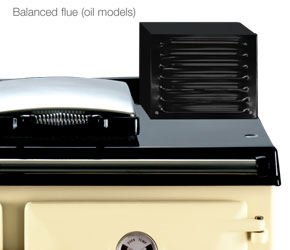 Balanced Flues
Balanced Flues
What is a flue and what does it do?
When we burn a fuel to release heat, gases such as Carbon Dioxide and water vapour together with some solid particles are produced, depending on the fuel being used. These need to be safely discharged into the outside atmosphere, where they quickly and harmlessly disperse. Solid fuel and wood-burning appliances need the flue to create a movement of air and thus oxygen across the firebed to make them burn. At some point of time in the burning cycle smoke may be produced or other particles which must also be taken away from the living areas.
The 'flue' is the means used to convey these 'products of combustion' from the cooker to outside.
Today's range cookers are highly efficient, incorporating state of the art burners and technology, thereby minimising emissions. Good news for our planet.
A flue can be part of a chimney, but there are various types and options, including models that can be flued directly through an outside wall.
The flue from a range cooker has one other important function to perform. During oven cooking operations, moisture is naturally driven off from the food. Our ovens are directly connected to the outside atmosphere, usually through the flue system, avoiding condensation and steam in the kitchen. So there's no need to deliberately open windows as you might need to with a conventional oven.
The cast-iron ovens have high surface temperatures ensuring that any fat splashes carbonise to powder; in effect, self cleaning. Any objectionable smells created are therefore also carried away by the flue.
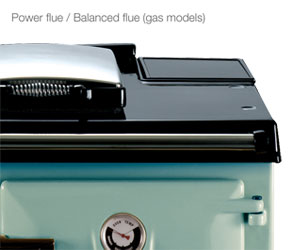 Power Flue
Power Flue
A Power flue may be the answer for properties where there is no conventional chimney and offers the flexibility for the cooker to be sited on an external or internal wall, even within an island or peninsular setting.
It uses a single, stainless steel flue-pipe, diameter 54mm. A variable speed, low voltage electric fan is fitted externally to provide the necessary suction.
A basic flue installation kit is supplied with the product, suitable for most installations up to 3m. Additional flue-pipe fittings and fastenings are available including 90 and 45 degree angle bends to allow flexibility of the flue route.
The pipe exits from the cooker through either the right or left hand side panel at low level, allowing for the pipe to be taken below work units if required.
It is possible to route the flue at high level or even under a floor, providing access can still be gained for cleaning the inside of the pipe. The flue can be extended up to 5 metres in length incorporating a maximum of 5 bends.
Current regulations dictate where power flues can terminate and there are minimum clearances required to nearby obstructions or opening windows & doors. Also minimum clearances above ground level. They should not terminate within car-ports.
A combustion air supply through an airbrick into the kitchen is required.
Oven venting is still a product feature and benefit, using the flue-pipe and fan to discharge externally.
Solid fuel and wood burning models are not available with a power flue.
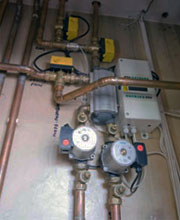 Rayburn Eco-Connect System
Rayburn Eco-Connect System
The Futer of Heating
Connecting traditional energy sources with the latest renewables technology can be problematic, but here at Rayburn, we have the answer - with the Eco-Connect.
The AGA Rayburn Eco-Connect Panel - the clever bit of technology that can link everything together. It enables the interconnection of different appliances, ensuring that energy is intelligently drawn from the greenest source at all times without having to fiddle with buttons and switches.
For British households, there has been no escaping the ever increasing cost of heating our homes, especially for properties that are off the gas grid and reliant on fossil fuels. In recent years, this has led to a host of renewable heating products which provide affordable options ideal for rural properties, with solar hot water and wood burning stoves becoming particularly popular in homes up and down the country.
However, for anyone who has had the foresight to install these products, there has always been one perennial problem: how do they all work together? In general, it is not always convenient to rely entirely on renewables energy, as quite often it can be insufficient when meeting the total heating and hot water demands of the owner's lifestyle. In such cases the fossil fuelled appliance has to be used as a backup, and although it has always been possible to design a shared plumbing system, combining sealed pipe work and traditional open-unvented systems can be a tough challenge.
With this in mind, Rayburn has developed the Eco-Connect, which allows interconnection of a renewable product - such as solid fuel/wood burning appliance or solar hot water panels - with an oil/gas fired boiler or a Rayburn central heating range cooker. The new device consists of a wiring centre, pump station and a heat exchanger, with associated motorised valves to which the various flow and return pipe work and electrical connections are made. Thermistors are used in conjunction with an intelligent control panel to sense the water temperature of the flow and return pipes and domestic hot water (DHW) cylinder. It also incorporates a display panel showing the current operating status and which energy source is being used.
In essence, hot water is diverted by the Eco-Connect to where it is needed. And if the renewable appliance (e.g. wood burning stove) is not giving sufficient output, then the automatic boiler or central heating Rayburn will be brought into operation. Priority is always automatically given to the renewable heat source.
So, for homeowners looking to incorporate renewables into their properties, but still want the reliability and backup of a traditional heating system, the Eco-Connect from Rayburn is the perfect solution.
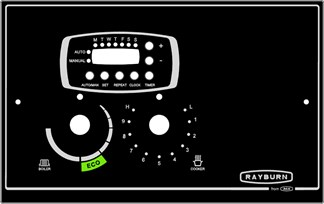 Running Costs & Efficiencies
Running Costs & Efficiencies
Control & Efficiency
One of the most common misconceptions about Rayburn is that they have to be 'always on'. In fact, the opposite is true, making them a bit like an on-off 'AGA'.
Even Rayburn solid fuel models offer automatic thermostatic control, while other fuel types allow for fully-programmable timers so that the Rayburn only provides the function you want when you need it. That's why Rayburn recommends a home survey to customers before they commission and install their range - to ensure they're buying the right model to suit their needs, and to recommend the best way to use a Rayburn in their home.
The fuel and heat efficiency of a Rayburn, because of their post-war origins, ensure that they do as much as possible for as little as possible. The use of cast-iron is designed to hold onto heat, and let it trickle out slowly to the home whilst cooking. Engineering and technological advances in the intervening years have greatly added to this basic benefit: Rayburn boilers are now highly rated for their energy efficiency and fuel use. More crucially, today's Rayburn ranges include many models that offer total, independent and programmable control over cooking, heating and hot water - so that every customer can tailor the use of a Rayburn to suit their own lifestyle.
Efficient energy use A Rayburn is built to create and store heat in the most efficient way possible, using traditional materials, teamed with modern engineering and high-spec insulation to save heat - and money. When a Rayburn is used for cooking, heating and hot water, it operates at a level of fuel efficiency that equals - and sometimes betters - the separate provision of these functions. When you also factor in the 'AGA effect' of radiant heat that a Rayburn brings to the kitchen, you have an ancillary energy source that offers the output of a conventional radiator. Our customers use this for everything from drying clothes and warming food to incubating farm animals or preparing dried herbs - at no extra cost.
Don't forget that a kitchen radiator on a central heating system has an output of around 1.5kW per hour and, providing it's fitted with a thermostat, will automatically turn off when the Rayburn is running. That's a saving of at least 7.5kW per day if the Rayburn is on for five hours - and probably more because it continues to release heat for a period after it's turned off.
| Rayburn type | Daily fuel/energy consumption (5hrs) |
| 200 series | |
| Wood or solid fuel (SFW) | 4.16 kg logs* |
| Natural gas (G) | 19.8 kW** |
| Propane gas (L) | 2.91 litres |
| 300 series | |
| Oil (K) | 2.05 litres |
| 400 series | |
| Natural gas (G) | 25.55 kW** |
| Propane gas (L) | 3.62 litres |
| Oil (K) | 2.53 litres |
| *Correctly seasoned hardwood logs | |
| ** Prices based on British Gas Standard with Energy Smart package for the Midlands - Sept 2012 | |
 The first step is to have a site survey carried out by a suitably qualified and competent installer (we would recommend a Rayburn Heat Centre Engineer) to ensure that you select the Rayburn that best meets your needs and requirements.
The first step is to have a site survey carried out by a suitably qualified and competent installer (we would recommend a Rayburn Heat Centre Engineer) to ensure that you select the Rayburn that best meets your needs and requirements.
As with other heating appliances, a Rayburn must always be installed, commissioned and serviced by a qualified and trained heating engineer.
Gas Rayburns - A gas Rayburn must be installed by a GAS SAFE registered engineer.
Oil fired Rayburns - An oil-fired Rayburn should be installed by an OFTEC registered engineer, who will complete the necessary completion certificate.
Solid Fuel Rayburns - A HETAS engineer should install a solid fuel Rayburn.
If the installation is to be carried out by other persons (excluding gas appliances that must be installed by a GAS SAFE engineer), the local authority Building Control Office must be notified in accordance with current Building Regulations (England & Wales).
For certain products within the Rayburn Range (660K, 680K, 699K, 680KCD & 480CD) if you have your installation carried out by a Rayburn Heat Centre Engineer, you can benefit from an extended warranty.
Before connecting a Rayburn to its flue, or inserting into a flue that has been previously used, the flue must be thoroughly swept of any soot and loose materials.
The first step is to have a site survey carried out by a suitably qualified and competent installer (we would recommend a Rayburn Heat Centre Engineer) to ensure that you select the Rayburn that best meets your needs and requirements.
As with other heating appliances, a Rayburn must always be installed, commissioned and serviced by a qualified and trained heating engineer.
We strongly recommend seeking the help of your Rayburn retailer and a local Rayburn Heat Centre Engineer to ensure you get best advice on the best Rayburn to suit your needs and what is needed for successful installation.
Frequently Asked Questions
Q. Where are Rayburns made?
A. The Rayburn is a British invention and all the castings are made in the Coalbrookdale foundry in Ironbridge, where we are proud of our history, having been at the birthplace of the industrial revolution. Every Rayburn is hand built in Shropshire by our master craftsmen and delivered to the home ready assembled for easy installation.
Q. Is a Rayburn controlled like a conventional cooker?
A. Very similar, apart from solid fuel cookers - which are controlled differently. They all offer supreme flexibility and complete controllability for cooking, and on larger models hot water and central heating. Twin burner, rapid-response models are extremely fast to heat up, giving roasting oven temperatures in around 30 minutes. Models with integral programmes give total control to suit modern lifestyles. Ovens can be regulated like a conventional cooker. For peace of mind, all our best retailers offer regular cooking demonstrations.
Q. Can I cook without running the central heating?
A. Yes. All twin-burner models have separate burners for cooking and heating. Certain models are also available with an electronic programmer so you can set the heating and cooker to come on independently in anticipation of your return home.
Q. Can I have a Rayburn that is for cooking only?
A. Yes, there are cooking only models for all fuel types, and some don't even require a chimney with the power flue option. The Rayburn family of cookers is the largest range available and there is a perfect model to suit every home.
Q. Do I have leave my Rayburn on all the time?
A. Traditional models are designed for continuous operation and are adjusted to provide the required temperatures. Rapid Response models are designed to be able to be turned on and off as required, and heat up is fast. If required these can also be operated on a special low setting to give a gentle warmth to the kitchen and for off-peak cooking.
Q. Will the kitchen get too hot?
A. The amount of insulation in a Rayburn, depending on model, is sufficient to provide some warmth to the kitchen as required. Traditional models give a gentle warmth at an idling setting, and more heat when at full roasting temperature. Rapid Response models are designed to be turned on and off as required, but may also be run on a low setting if required.
Q. Do you make balanced flue models?
A. Yes. Unlike many manufacturers we recognise that a balanced flue installation is often an attractive proposition. Different fuels and outputs are available. The Rayburn 480CD, 680CD and 780KCD use condensing boiler technology and feature balanced flues meaning there is no need for an existing chimney. There is also a power flue option for the 400G/400K or Rayburn XT.
Q. What about cleaning?
A. The cast-iron ovens are genuinely self-cleaning and a wire brush can be used to remove any burned-on deposits and also on the hotplate. Most spills simply burn off when the oven is at a high setting. The vitreous enamel exterior is easily cleaned using an approved proprietary vitreous enamel cleaner. The stainless steel parts can be cleaned with the Rayburn Stainless Steel and Chrome Cleaner.
Q. What happens in a power cut when a Rayburn is in use?
A. Solid fuel models, as well as the 208G, 300K and the 308K will continue to provide cooking and domestic hot water. All Rayburns will go into a safe mode when the electricity supply is interrupted and should automatically restart when it is restored. Neither the 400, 600, 800 Series or the 200G, will operate during a power cut.
Q. Do the burners make much noise?
A. The Rayburn family uses both atmospheric burners (which are virtually silent in operation) and pressure jet burners. Depending on which model you choose, pressure jet burners are audible, particularly when heating up, but the improvement in technology in the last few years means pressure jet burners are becoming ever quieter.
Q. Is a Rayburn safe to use around children?
A. A Rayburn is generally safer than most conventional cookers as there are no naked flames or very hot electric elements to touch. Its controls are also hidden away. Although the 'body' of a Rayburn is hot to the touch, its surface temperatures are not likely to cause significant injury and children soon learn to avoid hot objects. But as a general safety matter, children should not be allowed to play with a cooker or its controls or to interfere with fires or burners.
Step by step buying guide
Your step by step guide to buying and installing your new Rayburn.
Step one: Choosing your fuel type
Whether you're replacing an old model or making your first Rayburn purchase, it's worth considering the most appropriate fuel type for your needs. Of course in some circumstances this will be an easy decision, but with solid fuel, wood, oil, gas and electric models available - each with their own distinctive benefits - looking at all the options is a good starting point.


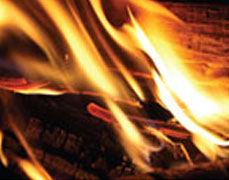

Step two: Select your model
Once you've chosen your fuel type, identify what you want your Rayburn to be used for. Is it cooking only, or do you want it to provide hot water and heating? Either way, the Rayburn model selector is the best starting point to narrow down your options and choose that all important colour.
If heating is an important feature of your Rayburn purchase, consider how many radiators you want to run as Heatranger models vary in output. To get an exact heating load (measured in kW), ask the trained engineer at your site survey.

Step three: Site survey
Having a survey carried out by a qualified and competent installer will help ensure you get the Rayburn that suits your individual requirements. We can arrange this through our preferred contractor H & G Sims Ltd
During the survey you will be advised where your new Rayburn will be best situated, as well as plan the flueing layout and heating and hot water system. The survey is also a good opportunity to discuss the integration of any renewable energy such as wood burning stoves, solar thermal or solar electric, as well as ask any questions.
Step four: Installation
It might sound like the most difficult part, but installing your new Rayburn is a relatively simple job. The images below show a typical installation of an oil-fired Rayburn 680KCD with a conventional flue.
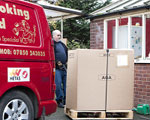
Rayburn arrives securely packaged and fully assembled with just the doors to hang.
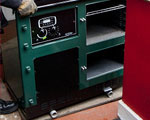
To ensure the Rayburn is not damaged, it is carefully brought into the property on rollers.
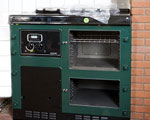
As approved in your site survey, the Rayburn is moved into place.
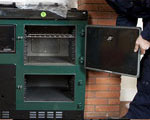
The doors are hung
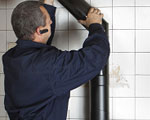
A Pre-assembled flue kit is attached to the Rayburn and connected to the chimney. This will vary for different models and flue types.

If you have chosen a Heatranger model, the central heating system is flushed, and a magnetic filter fitted to collect any harmful deposits from the system - protecting your new Rayburn.
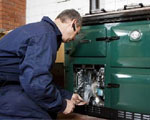
The burner is commissioned by the engineer and the Rayburn is thoroughly checked over for any faults.
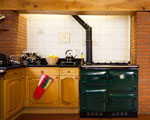
Your new Rayburn is handed over ready to go. But first the engineer will give you a full demonstration of the controls and remind you about the importance of regular servicing.
Step five: Christen your new Rayburn with a cooked breakfast!
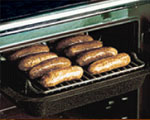 The combination of hotplates and cast iron ovens ensures the Rayburn is perfect for every kind of cooking - especially a cooked breakfast so it's time to get started with your culinary masterpiece!
The combination of hotplates and cast iron ovens ensures the Rayburn is perfect for every kind of cooking - especially a cooked breakfast so it's time to get started with your culinary masterpiece!
Step six: Visit your local Rayburn demonstration
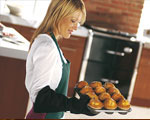 For those of you who are new to cooking on a Rayburn, why not get some tips from a pro at your Rayburn demonstration? As well as basic tips and advice - which show how to get the most from your cooker - there are also themed versions covering all sorts of interesting cooking topics. The demonstrators are happy to answer your questions and best of all, guests get to sample all the delicious food that's been cooked.
For those of you who are new to cooking on a Rayburn, why not get some tips from a pro at your Rayburn demonstration? As well as basic tips and advice - which show how to get the most from your cooker - there are also themed versions covering all sorts of interesting cooking topics. The demonstrators are happy to answer your questions and best of all, guests get to sample all the delicious food that's been cooked.
So whether you're a seasoned Rayburn cook looking to build your repertoire, or entirely new to the world of Rayburn, it's well worth booking a place at a demonstration as you're sure to learn lots of interesting new things.
Step seven: Regular servicing
 To ensure your Rayburn is always running at optimum efficiency, it's important to have it regularly serviced. The Rayburn Heat Centre is a nationwide network of authorised dealers and independent engineers committed to providing a first class after sales service. We can connect you to our local engineers
To ensure your Rayburn is always running at optimum efficiency, it's important to have it regularly serviced. The Rayburn Heat Centre is a nationwide network of authorised dealers and independent engineers committed to providing a first class after sales service. We can connect you to our local engineers
